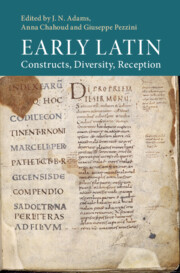Book contents
- Early Latin
- Early Latin
- Copyright page
- Dedication
- Contents
- Illustrations
- Tables
- Contributors
- Acknowledgements
- Abbreviations
- Chapter 1 Introduction: What Is ‘Early Latin’?
- Part I The Epigraphic Material
- Part II Drama
- Part III Other Genres and Fragmentary Authors
- Part IV Reception
- Chapter 20 ‘Early Latin’ and the Fragments of Atellane Comedy
- Chapter 21 Lucretius and ‘Early Latin’
- Chapter 22 Cicero and Early Dramatic Latin
- Chapter 23 Early Latin Texts in Livy
- Chapter 24 Pliny Rewrites Cato
- Chapter 25 Gellius’ Appreciation and Understanding of ‘Early Latin’
- Chapter 26 Views on ‘Early Latin’ in Grammatical Texts
- Chapter 27 Nonius Marcellus and the Shape of ‘Early Latin’
- Chapter 28 ‘Early Latin’ to Neo-Latin
- Chapter 29 Conclusions
- Bibliography
- Index Verborum
- Index of Non-Latin Words
- Index Locorum Potiorum
- Subject Index
Chapter 29 - Conclusions
‘Early Latin’ as a Concept
from Part IV - Reception
Published online by Cambridge University Press: 27 July 2023
- Early Latin
- Early Latin
- Copyright page
- Dedication
- Contents
- Illustrations
- Tables
- Contributors
- Acknowledgements
- Abbreviations
- Chapter 1 Introduction: What Is ‘Early Latin’?
- Part I The Epigraphic Material
- Part II Drama
- Part III Other Genres and Fragmentary Authors
- Part IV Reception
- Chapter 20 ‘Early Latin’ and the Fragments of Atellane Comedy
- Chapter 21 Lucretius and ‘Early Latin’
- Chapter 22 Cicero and Early Dramatic Latin
- Chapter 23 Early Latin Texts in Livy
- Chapter 24 Pliny Rewrites Cato
- Chapter 25 Gellius’ Appreciation and Understanding of ‘Early Latin’
- Chapter 26 Views on ‘Early Latin’ in Grammatical Texts
- Chapter 27 Nonius Marcellus and the Shape of ‘Early Latin’
- Chapter 28 ‘Early Latin’ to Neo-Latin
- Chapter 29 Conclusions
- Bibliography
- Index Verborum
- Index of Non-Latin Words
- Index Locorum Potiorum
- Subject Index
Summary
Dividing the Latin language into neat chronological periods will not work without severe reservations. Usages that may seem to be ‘early’ often turn out not to be confined to a particular period, or alternatively their attestations may be genre-related, that is characteristic of a genre that happens to survive mainly from an early period. As for ancient grammarians and commentators on the language, no single concept of what early Latin is may be extracted from their works. Early Latin, or the Latin of ueteres, was a different thing for different commentators. One could use ‘early Latin’ (arbitrarily) of the Latin of the period before about 100 BC, provided that one excludes from the category ‘early’ usages which, though they were current early, also remained current beyond that time. Latin is attested over many centuries, and it was definitely not static. There was not however an entity ‘early Latin’ in use until a convenient date, which then changed into ‘classical Latin’. Recovery of early phenomena requires careful analysis of the distribution, comparative evidence across periods and genres, and a distinction between usage and fashion.
Keywords
- Type
- Chapter
- Information
- Early LatinConstructs, Diversity, Reception, pp. 582 - 596Publisher: Cambridge University PressPrint publication year: 2023

